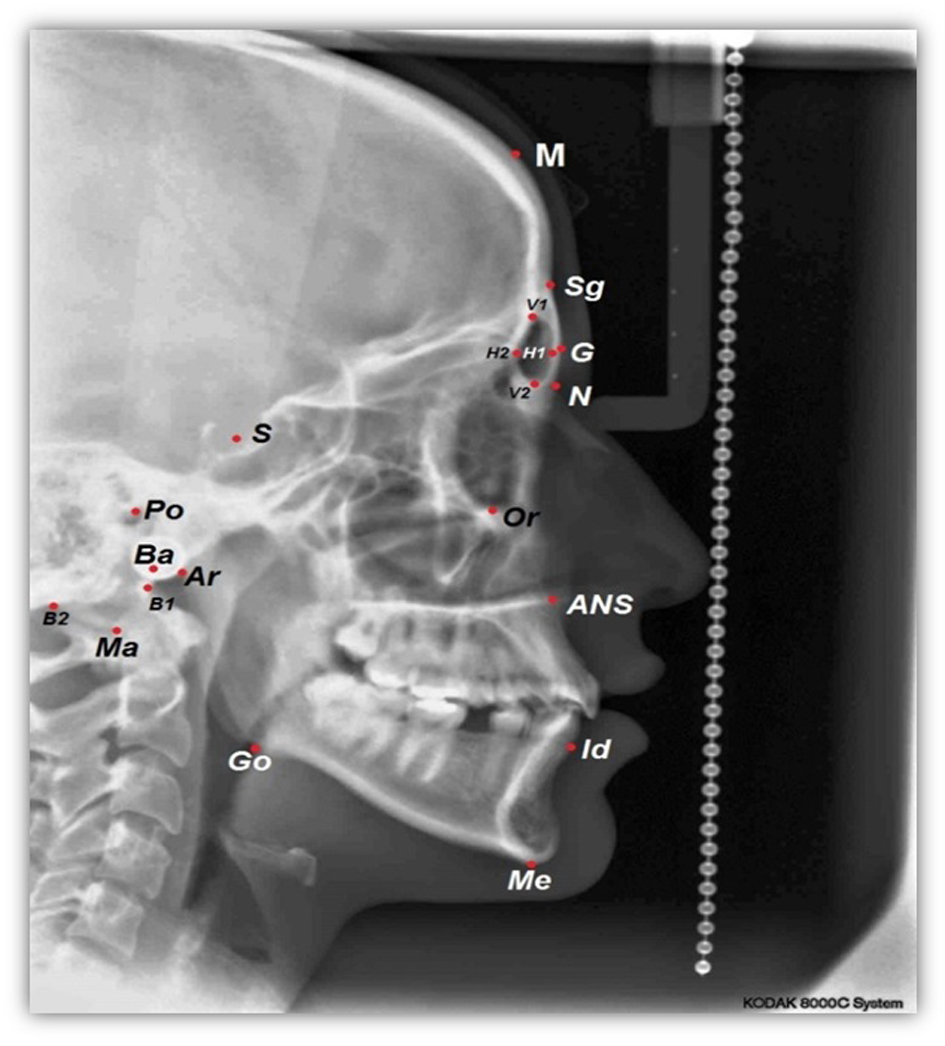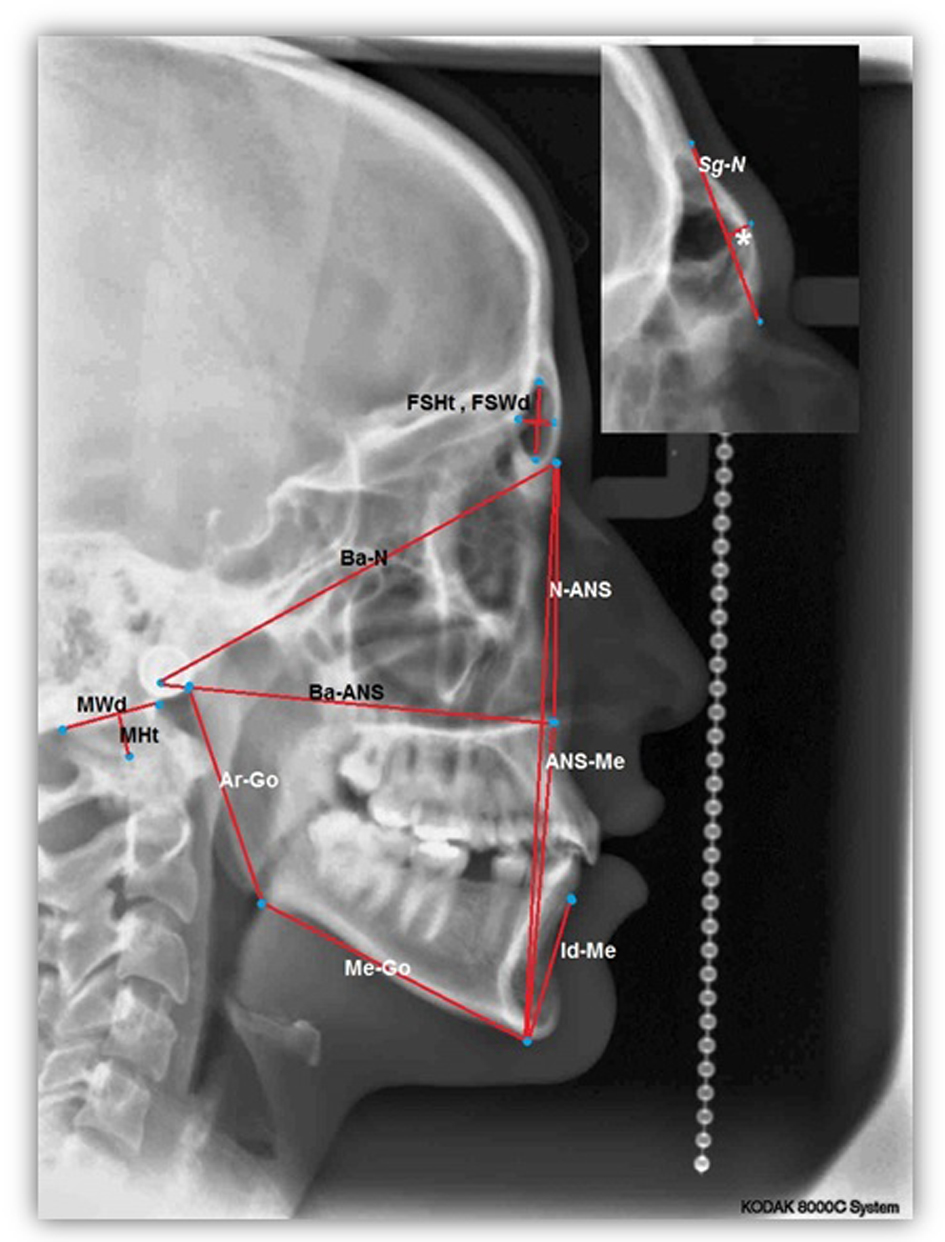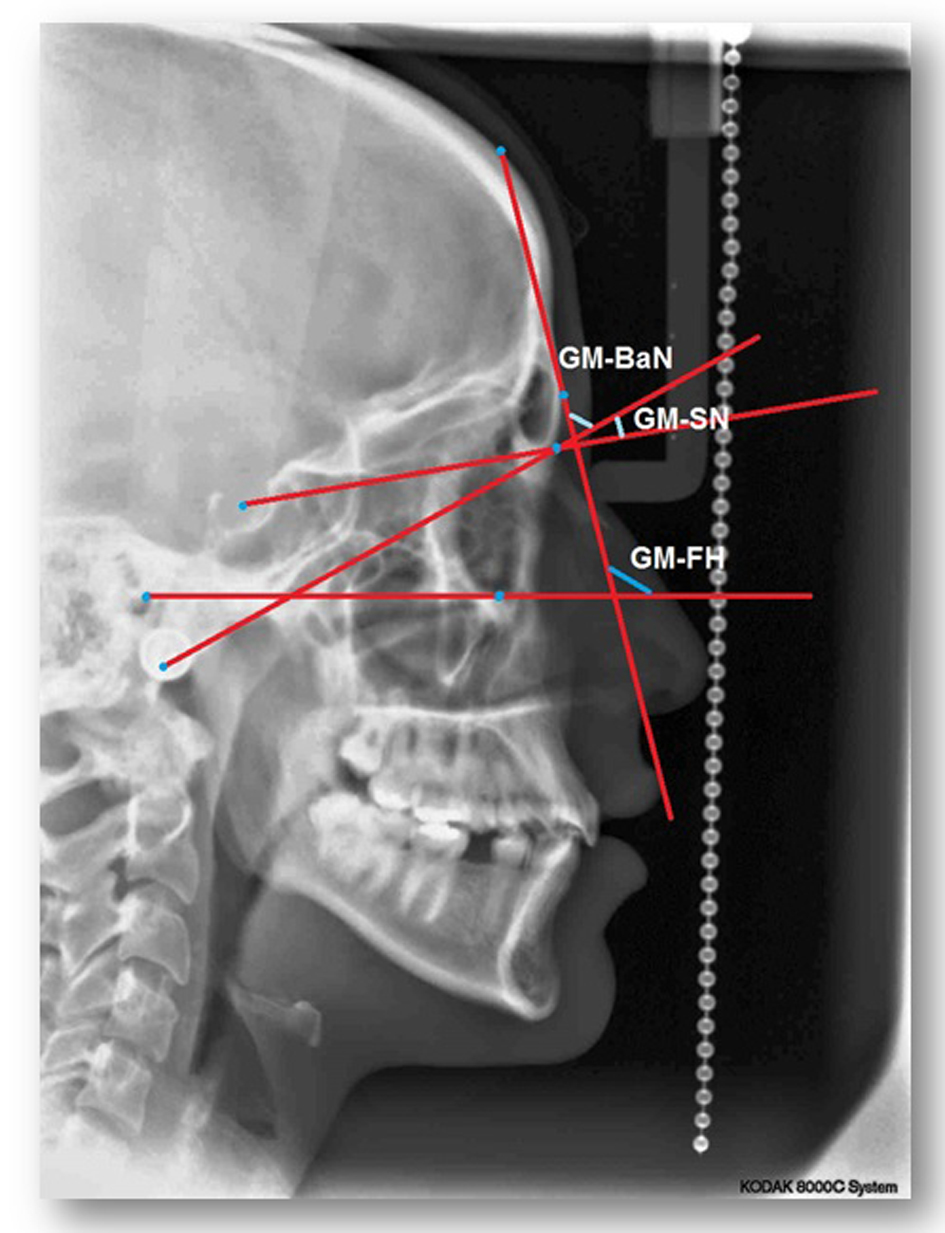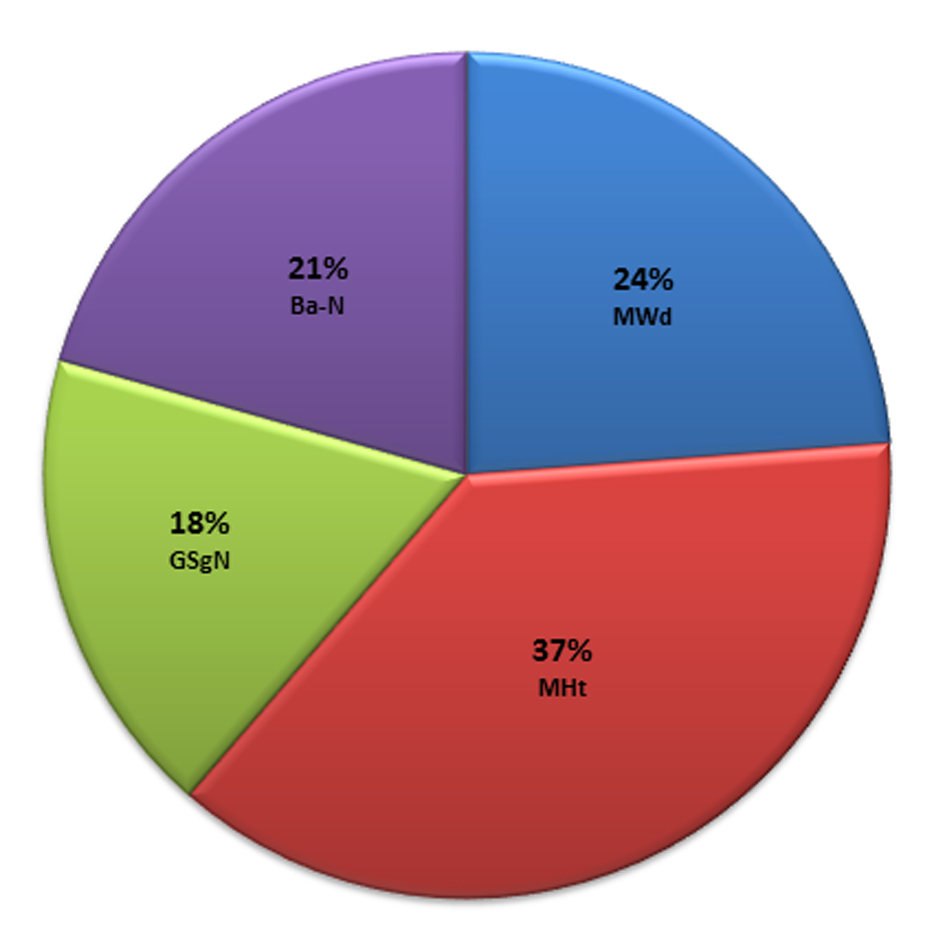
Figure 1. A cephalometric radiograph illustrating the landmarks defined in Table 1.
| Journal of Current Surgery, ISSN 1927-1298 print, 1927-1301 online, Open Access |
| Article copyright, the authors; Journal compilation copyright, J Curr Surg and Elmer Press Inc |
| Journal website http://www.currentsurgery.org |
Original Article
Volume 4, Number 3, September 2014, pages 76-85
Gender Dimorphism of Crania in Young Jordanian Adults: Discriminant Function Analysis Approach for Gender Prediction
Figures




Tables
| Name | Abbreviation | Description |
|---|---|---|
| Metopion | M | Point where the line that connects the highest points of the frontal eminences crosses the sagittal plane. |
| Supraglabellare | Sg | Most posterior midline point in the supraglabellar fossa, the concavity between glabella and metopion most posterior midline point in the supraglabellar fossa. |
| Glabella | G | Most anterior point in the midsagittal plane between the superciliary arches. |
| Nasion | N | Most anterior point on the fronto-nasal suture in the midsagittal plane. |
| V1 | Upper parameter of the frontal sinus cavity. | |
| V2 | Lower parameter of the frontal sinus cavity. | |
| H1 | Anterior parameter of the frontal sinus cavity on bregma to nasion line, the line from the inner location of bregma to nasion. | |
| H2 | Posterior parameter of the frontal sinus cavity on bregma to nasion line. | |
| Sella | S | Midpoint of sella turcica, hypophyseal fossa. |
| Orbitale | Or | Lowest point on the lower margin of the bony orbit. |
| Porion | Po | Top of the external auditory meatus. |
| Basion | Ba | Most inferior posterior point in the sagittal plane on the anterior rim of the foramen magnum. |
| Mastoidale | Ma | Lowest point of the mastoid process. |
| B1 | Anterior parameter of the mastoidale width at the level of cranial base. | |
| B2 | Posterior parameter of the mastoidale width at the level of cranial base. | |
| Menton | Me | The lowest point on the symphyseal shadow of the mandible seen on a lateral cephalogram. |
| Gonion | Go | A point on the curvature of the angle of the mandible located by bisecting the angle formed by lines tangent to the posterior ramus and the inferior border of the mandible. |
| Articulare | Ar | A point at the junction of the posterior border of the ramus and the inferior border of the posterior cranial base (occipital bone). |
| Anterior nasal spine | ANS | The anterior tip of the sharp bony process of the maxilla at the lower margin of the anterior nasal opening. |
| Parameter | Description | |
|---|---|---|
| Linear measurements | ||
| Ba-ANS | Basion to anterior nasal spine. | Depth of face. |
| Ba-N | Basion to nasion. | Length of skull base. |
| N-ANS | Nasion to anterior nasal spine. | Height of upper face. |
| ANS-Me | Anterior nasal spine to Menton. | Height of lower face. |
| N-Me | Nasion to Menton. | Anterior height of face. |
| Id-Me | Infradentale to Menton. | Height of mandibular symphasis. |
| Ar-Go | Articular to gonion. | Height of mandibular ramus. |
| Me-Go | Menton to gonion. | Length of mandibular body. |
| FSHt | V1 to V2. | Frontal sinus height. |
| FSWd | H1 to H2. | Frontal sinus width. |
| MHt | Mastoidale to B1-B2. | Mastoid height. |
| MWd | B1 to B2. | Mastoid width. |
| Sg-N | Supraglabellar to nasion. | |
| GSg-N | Glabella to Sg-N (distance between glabella and the supraglabellare to nasion line). | |
| Angular measurements | ||
| GM-Ba-N | Glabella-metopion to Basion-nasion. | |
| GM-SN | Glabella-metopion to Sella-nasion. | |
| GM-FH | Glabella-metopion to Frankfort plane (porion-orbitale). | |
| Proportional | ||
| GPI | GSg-N/Sg-N × 100% | Glabella projection index. |
| Parameter | Male (N = 47) | Female (N = 99) | Tests of equality of group means | Classification accuracy (%) | ||||
|---|---|---|---|---|---|---|---|---|
| Mean | SD | Mean | SD | Wilks’ lambda | F | Sig. | ||
| *Degrees of freedom: 1 and 144. *Significance level considered: P < 0.05. | ||||||||
| Linear measurements (mm) | ||||||||
| Sg-N | 40.34 | 5.67 | 37.77 | 5.15 | 0.95 | 7.42 | 0.007 | 71.2 |
| N-Me | 152.98 | 9.09 | 145.85 | 8.36 | 0.87 | 21.87 | 0.000 | 72.6 |
| N-ANS | 65.31 | 4.69 | 62.91 | 4.26 | 0.94 | 9.5 | 0.002 | 70.5 |
| MWd | 29.56 | 3.4 | 26.17 | 3.89 | 0.85 | 26.07 | 0.000 | 69.9 |
| MHt | 17.84 | 4.34 | 10.52 | 3.04 | 0.51 | 138.73 | 0.000 | 82.2 |
| Me-Go | 89.8 | 6.33 | 90.22 | 6.8 | 1.00 | 0.13 | 0.722 | 67.8 |
| Id-Me | 41.72 | 3.67 | 39.24 | 3.78 | 0.91 | 13.94 | 0.000 | 70.5 |
| GSg-N | 4.26 | 1.63 | 3.08 | 1.15 | 0.85 | 25.16 | 0.000 | 71.2 |
| FSWd | 31.95 | 8.18 | 30.56 | 7.47 | 0.99 | 1.04 | 0.310 | 67.8 |
| FSHt | 13.23 | 4.00 | 11.07 | 2.74 | 0.91 | 14.49 | 0.000 | 73.3 |
| Ba-ANS | 115.65 | 7.36 | 112.18 | 7.35 | 0.95 | 7.09 | 0.009 | 67.1 |
| Ba-N | 129.62 | 7.98 | 123.63 | 7.25 | 0.88 | 20.38 | 0.000 | 70.5 |
| Ar-Go | 56.12 | 8.43 | 52.46 | 5.35 | 0.93 | 10.14 | 0.002 | 70.5 |
| ANS-Me | 88.67 | 7.08 | 83.85 | 6.96 | 0.9 | 15.13 | 0.000 | 69.2 |
| Angular measurements (°) | ||||||||
| GM-SN | 97.85 | 7.04 | 94.37 | 4.94 | 0.92 | 11.86 | 0.001 | 72.6 |
| GM-FH | 105.86 | 6.09 | 102.39 | 5.21 | 0.92 | 12.65 | 0.001 | 70.5 |
| GM-Ba-N | 79.31 | 6.35 | 76.7 | 4.68 | 0.95 | 7.82 | 0.006 | 71.2 |
| Proportional (%) | ||||||||
| GPI | 10.43 | 3.29 | 8.07 | 2.53 | 0.86 | 22.72 | 0.000 | 69.9 |
| Parameter | Coefficient |
|---|---|
| MWd | 0.4378 |
| MHt | 0.6904 |
| GSg-N | 0.3306 |
| Ba-N | 0.3789 |
| Model | Classification accuracy (%) | Cross-validated (%) | Classification accuracy (%) | Cross-validated (%) | ||
|---|---|---|---|---|---|---|
| Male | Female | Male | Female | |||
| All parameters | 89.7 | 85.6 | 80.9 | 93.9 | 72.3 | 91.9 |
| All angular parameters | 71.9 | 70.5 | 25.5 | 93.9 | 21.3 | 93.9 |
| All linear parameters | 87.7 | 85.6 | 78.7 | 91.9 | 72.3 | 91.9 |
| Proportional parameter | 69.9 | 69.9 | 27.7 | 89.9 | 27.7 | 89.9 |
| Stepwise model | 87.7 | 87.0 | 74.5 | 93.9 | 72.3 | 93.9 |